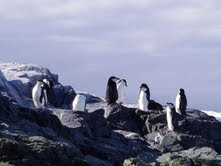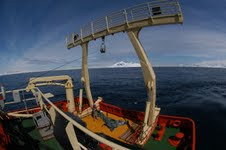Note from Joe: We got a great set of questions from Ms. Ungchusri's 8th grade class from Texas. The field team has been working hard to come up with answers to them so here they are.
 |
| Sometimes if you take enough pictures, you can catch a porpoising penguin in the air! |
1 - What's the range of temperature outside? What is the coldest temperature you have recorded?
Karen: I have not been measuring outside temperature myself, but it seems as though the air temperature is ranging from around 40 degrees Fahrenheit on a really sunny day to around 15-20 degrees Fahrenheit on a cold evening.
Joe: The ship has a system that measures the air temperature (and wind chill) so you can see how cold it is outside before going out on deck (and deciding if you need one or two pairs of socks). Air temps are right around freezing normally, but with wind chill can be another 20 or 30 degrees colder.
2 - Are there polar bears? Are they friendly?
Karen: There are no polar bears in Antarctica; they only live in the arctic (where the North Pole is). There, they are known to hunt people and are not friendly.
3 - Is day to day living hard over here?
Karen: Day to day living is not hard. Our research vessel is very comfortable. We work very hard, though. Long hours of work with little sleep are the hardest things about day to day life.
4 - How do they grow vegetables/vegetation?
Karen: On the ship, we bring all of our fresh vegetables with us. The ship also delivers fresh produce to Palmer Station. At McMurdo Research Station, they have a green house and can grow some of their own vegetables.
5 - How long are the days/nights during the different seasons?
Karen: Right now, in the summer, daylight lasts almost all day. In fact, it never gets dark. Between around 11:00pm and 2:00am it looks like dusk outside. By 3:00am the sun is already above the horizon! The opposite is true in the winter (our summer, June-September)
6 - What is the favorite part of your work?
[Note from Joe: I had everybody in the field team answer this question, but they came up with the same answer!]
Katie: My favorite part of my work is when we pull up the zooplankton nets! While typically the usual suspects are present, such as krill and salps, you never know what you're going to get!! Last night Karen and I caught a large purple ctenophore. It was still alive and looked as if it was glowing!
 |
| Heres a picture of the star of one of our recent catch! Photo by Karen. |
Melissa: My favorite part of work out here is trying to guess what we’re going to get in the cod end and then finally looking at what we got. Sometimes we get something really interesting and/or weird like polychaete worms or fish larvae. It’s also pretty cool when we get a long salp chain although it can be frustrating to try not to break it apart when we move the sample around.
Karen: My favorite part of this work that we are doing is getting to open up the cod end (the strainer at the end of the net where our zooplankton samples are collected as we tow our sampling net) after a tow and see what neat creatures we have caught.
7 - Can you play soccer outside? If yes, do the penguins play too?
Katie: I love soccer and would love to play with the penguins!!! I've seen them playing in Coca Cola commercials. I've yet to find a soccer ball laying around the ship, but if I do, maybe I'll try it.
Joe: On my last cruise, we had a soccer game in a big room on the ship where they sometimes store a helicopter. However, the ship we're on right now doesn't have a room like that. And it's dangerous to play soccer on the deck because if the ball goes over the side, you can't get it back!
8 - How long does it take to travel to Antarctica from North America?
Katie: A long time! It took me about 27 hour total to fly to Punta Arenas, Chile and then a 4 to 5 day boat ride to Antarctica!
9 - Does it rain in Antarctica or does it just snow?
Katie: Where we are, near the Antarctica Peninsula, it is possible for it to rain if it is warm enough (above thirty two degrees F). Most days it is not that warm, so it snows. Today is an exception though - its almost forty degrees and sunny!
10 - What modes of transportation do you use on Antarctica?
Katie: All transportation to and from Antarctica is by ship or plane. Once you get to the continent, there are trucks, snowmobiles, and more!
11 - Does Antarctica look the same 20 years ago as it does today? Is it affected by global warming? Is global warming real or fake? Will everything melt one day?
Joe: I've been coming down to Antarctica for only the past 10 years but I work with people who have worked here for more than 30 years studying animals and their habitat. There are definitely changes occurring on the continent here even though we are relatively isolated from the rest of the people on earth. The peninsula (the part of the continent that reaches up towards South Amera) is getting warmer at a rate much faster than the rest of the planet and scientists have started to observe changes in where they find certain penguin species which may be the result in climate change affecting their habitat or where they may find their preferred food (like krill). Climate change is real -- but depending on where you are on the planet, the effects may be mild or strong. I don't think everything will melt one day, however we may see changes in what areas of our planet are habitable for people (just like we're seeing changes in the penguins down here).
12 - What kind of food do you eat when you are there?
Katie: The food on the ship is delicious! I eat pretty much what I would if I were at home, but more cookies! The cookies are very tasty. Our trip is relatively short, so we still have some supplies of fresh fruits and vegetables, but this is not the case for all trips.
13. What language do you speak in Antarctica?
Melissa: Mostly we speak English, but occasionally we like to rattle off a little penguin or whale.
Joe: However, if you visit another country's research station, they speak their native language so you could hear spanish, chinese, korean, russian, polish, or several other dialects.
14. How much bigger is Antarctica than Texas?
Melissa: It’s way bigger (and way cooler) than Texas.
Joe: Melissa used to live in Texas. Joe and this blog takes no official stance on which location is cooler. The size of Antarctica depends on what season you are here as there is a lot of ice that freezes around the continent. It's around 5.4 million square miles in area. I don't know the size of Texas, but I'm guessing you could fit ~ 20 Texas(es) in Antarctica -- maybe your class can calculate how many and see how close my guess is ? We also have several people from Alaska on our ship and they would like to point out that Alaska is 600,000 square miles or roughly twice as large as Texas.
15. What kind of penguins are found there?
Melissa: While I’ve been down here I’ve seen mostly chinstraps but I’ve also seen a few Adelie’s and gentoo’s. While we were out on a small boat trip we even saw an emperor penguin, although they aren’t common in the islands where we’ve been. Mostly, the emperor penguins live down on the continent but they will move north to molt their feathers.
16. Do you shower even if it is freezing?
Melissa: Well, luckily the ship has a water heater so we don’t have to take freezing showers. The real issue with showering happens when the ship is rocking back and forth. It’s easy to get seasick in an enclosed space and it can be difficult to hold on to the hand rail and wash/dry at the same time.
17. Is there a big community of people over there? What do you use to get around?
Melissa: There are a lot of people out here, actually. A bunch of countries have their own stations in Antarctica that are like their own small communities and there are constantly people there working and maintaining them. The stations have vehicles for moving around in some areas on land but you can also take a zodiac, which is a small boat, to travel to other islands and explore on foot.
18. What kind of noises do penguins make?
Melissa: It’s kind of like a nasal squawk. Almost like a crow with a deep voice.
Joe: Sometimes when they are on land, the penguins will "trumpet" which sounds like (you guessed it) a trumpet.













































